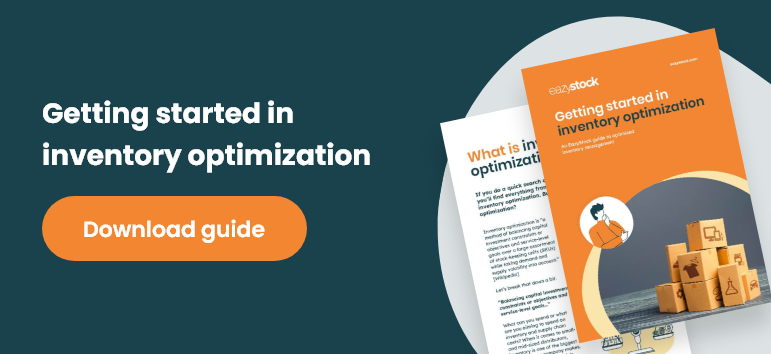Demystifying key inventory terms: Your inventory optimization glossary
Inventory optimization is a complex but crucial aspect of supply chain management. However, if you haven’t heard of inventory optimization, you might not know just how crucial it is. In this post, EazyStock‘s experts have broken down key inventory optimization terms and concepts to provide a solid foundation to build on.
Let’s start with the basics.
What’s inventory optimization?
Holding too much stock ties up cash that could be saved or invested in other business areas. Not holding enough stock means you won’t be able to meet customer demand and you’ll lose sales to competitors.
Inventory optimization balances high service levels with the lowest possible inventory investment. You find the best – or optimal – level of inventory you need to hold to meet customer demand, including safety stock.
Inventory optimization helps:
- reduce excess stock levels and the risk of ending up with obsolete stock that needs to be sold off at a heavy discount or written off altogether.
- save money and reduce total costs by only investing in stock that is needed.
- ensure customer satisfaction by supplying customers with what they need, when they need it.

How is inventory optimization different to inventory management?
Inventory management is one part of the supply chain. It is about overseeing and supervising the flow of goods from suppliers to warehouses and customers. Inventory management is responsible for ordering, managing, storing and moving inventory.
Inventory optimization enhances inventory management by using advanced algorithms to improve demand forecast accuracy. It also automates managing supply variables and dynamically adjusts stock rules and inventory parameters to ensure you have the right products in the right place at the right time.
There are three stages to inventory optimization:
- Demand forecasting – demand types, the product lifecycle, seasonality, trends and promotions.
- Stocking policies – stock classification, multi-location inventory planning.
- Replenishment – replenishment calculations and automatic daily order proposals.
Whether you’ve been working with inventory for years or you’re new to the industry, here are key inventory management terms to help you embark on your inventory optimization journey.
You can read more in our eGuide – An introduction to inventory optimization.
Inventory
Inventory is the heart of supply chain management. It refers to the goods and materials a business holds for resale or production.
Product lifecycle
There are four stages in a product lifecycle – launch, growth, maturity and decline. All products will move through a unique product lifecycle where they will see demand change. A growth product will see consistently high demand, while a declining product will have more volatile demand.
As demand differs at each stage of the product lifecycle, each stage has a unique statistical algorithm for calculating demand. Therefore, using the most relevant statistical algorithm for the item’s place in its lifecycle is essential for accurate demand forecasting.
Read more about the product lifecycle in our blog.
Demand types
An item’s demand type ties in with its place in the product lifecycle and will dictate which demand forecasting method you use. By analyzing historical sales and demand data, you can group items according to demand type and forecasting model. Demand classifications could be new, fast, slow, erratic, lumpy, non-moving and obsolete demand types.
Seasonality
Demand is impacted by seasonality, trends and promotional activity. Seasonality is where you have repetitive peak seasons, such as winter for warm clothes and summer for garden furniture. Identifying seasonal patterns and adjusting forecasts accordingly helps prevent shortages during peak seasons and excess stock once demand tails off.
Service level
Service level is another way of saying stock availability, which measures whether an item was out of stock when requested, leading to an unfulfilled order. Another way of saying this is by looking at whether you could meet historical demand or sales orders with existing inventory. A 60% service level means that there’s a 40% chance of a stockout.
Days of supply
Days of supply refers to how many days your current stock levels will last.
Stockout
A stockout is when you run out of items completely and cannot fulfil any orders.
SKU (Stock Keeping Unit)
SKUs (Stock Keeping Units) are unique identifiers for individual products in your inventory. They play a crucial role in tracking and managing products efficiently.
Lead time
Lead time is how long it takes for a supplier to deliver products to your warehouse or chosen location after placing an order with a supplier. It directly affects when you need to reorder items to maintain optimal stock levels.
Stock turnover
Stock turnover, also known as inventory turnover, indicates the speed at which companies sell and replenish their inventory. A higher turnover rate signifies efficient inventory management.

Just-in-Time (JIT)
Just-in-Time is an inventory management strategy where companies order and receive inventory just in time for production or sale. It aims to reduce holding costs and improve operational efficiency. This works best where there aren’t any issues in the supply chain, as it requires accurate demand forecasting.
Just-in-Case (JIC)
Just-in-Time is an inventory management strategy that involves holding large quantities of products in reserve to safeguard against unforeseen challenges. However, holding more stock consumes more warehouse space, increases storage costs and ties up capital you could use elsewhere.
Safety Stock
Safety stock, often called buffer stock, acts as your insurance policy against unexpected demand spikes or supply disruptions. By holding calculated additional stock levels, you can ensure you can meet customer demand, even in uncertain situations.
Dead stock or obsolete stock
Dead stock refers to items that are no longer in demand or have become obsolete. Effective inventory management minimizes dead stock, freeing up capital and space.
Replenishment
Replenishment is knowing how much stock to order and when to reorder it. Replenishment involves calculating reorder points and reorder quantities with sufficient safety stock levels to prevent stockouts.
Reorder point
The reorder point is the critical inventory level at which you should initiate a new order to replenish stock. It considers factors like lead time, demand, and safety stock.
EOQ (Economic Order Quantity)
EOQ is a formula that helps determine the optimal order quantity to minimize total ordering and holding costs. It is a fundamental concept in maintaining the right balance of inventory.
MOQ (Minimum Order Quantity)
MOQs are the smallest number of an item that a supplier will sell in a single order. Suppliers usually set MOQs to cover production and delivery costs to make it cost-effective for them to produce the items.
Demand forecasting
Before optimizing inventory, you must understand demand forecasting. This process helps you predict future product demand by analyzing historical data and market trends. A solid forecast is essential for keeping stock at appropriate levels.
Stocking policies
Stocking policies aim to prioritize the stock you carry to hold more of the items that are important to the business. Inventory classification models such as ABC analysis and ABC XYZ analysis segment items based on their value and demand variability.
ABC analysis
ABC analysis categorizes inventory items based on their importance to your business, helping you allocate resources where they’re most needed. This step ensures you focus on the most vital items.

ABC XYZ analysis
ABC XYZ analysis takes ABC analysis to another level by including demand variability of an item alongside its value to a business. This extra insight allows you to make more informed ordering and stocking decisions, such as the likelihood that demand will vary from the forecast.
Inventory policy
Inventory policy is a set of rules and guidelines businesses use to manage inventory. It includes factors like reorder points, safety stock levels, and order quantities, ensuring efficient and consistent inventory management.
Fill rate
Fill rate measures the ability to fill orders, which is different from service level. Fill rate considers how large a stockout is, not just how often a stockout happens. For example, a 60% fill rate indicates that 60% of the requested items are in stock and available immediately.
BOM (Bill of Materials)
A bill of materials is a structured list of components and materials necessary to build a product. BOMs help inventory management teams to forecast and order the right quantities of each material or component to make the end product. Ensuring the right quantities of each arrive when needed reduces production, servicing and order fulfillment delays.
ERP (Enterprise Resource Planning)
Enterprise Resource Planning systems (ERPs) integrate various business aspects, including inventory management. However, most ERPs offer only basic inventory functionality suitable for stock counting, so they aren’t suitable as inventory systems. They involve manual calculations and error-prone spreadsheets, and can only provide static reorder points and limited stock level control.
WMS (Warehouse Management System)
A Warehouse Management System (WMS) offers basic tools for optimizing and controlling warehouse operations, enhancing efficiency in inventory management, order processing, and logistics.
Inventory optimization in practice
We’ve explored a lot of terms and concepts here, which might make inventory optimization seem complicated. However, with the right tools, inventory optimization improves the efficiency and cost-effectiveness of inventory management processes.
EazyStock inventory optimization software makes inventory optimization, well, easy! It’s the key to achieving inventory optimization effortlessly and efficiently.
EazyStock’s tools and functionality simplify the process by automating manual forecasting and calculations to improve planning practices. It seamlessly connects with ERPs or WMS to enhance decision-making and streamline operations.
Ready to see it in action? Book a demo with us today and take the first step towards smoother inventory control.








